Console Evolved: A Halo: Combat Evolved Retrospective
Part 1: Halo: Combat Evolved
Introduction
Once in a generation, lightning strikes: a developer manages to produce pure magic, a new idea sets the industry alight or a game comes along that redefines an entire genre; in 2001, that developer was Bungie, that idea was the flagship for Microsoft’s new gaming machine and the game? The game was Halo: Combat Evolved, its subtitle well and truly earned.
Halo means a lot to me. Over the coming weeks and months I want to take you on a journey back through time with this retrospective review series, back through the 2000’s as we chart the rise and fall of Halo, review each game in the series and appreciate the seismic impact they had not only on the FPS genre but on gaming as a whole.
I hope you’ve got a beverage ready and are sitting comfortably, it’s going to be a long one. This is the Scanlines’ Journal Halo: Combat Evolved retrospective.
Delivering Hope
Halo 1’s journey onto shelves was not a smooth one.
Originally conceptualised as a real-time strategy game, then as a third-person shooter before finally evolving into the First-Person Shooter we know and love, Halo: Combat Evolved was never too far from failure. Not often remembered today is the fact that Bungie were Mac-centric developers prior to Halo, known for the cult-classic FPS series Marathon and the RTS game Myth: The Fallen Lords; to put it into perspective, Microsoft had placed the fate of their console launch in the hands of a team most people hadn’t heard of with a game that didn’t stop changing genres being developed under brutal crunch conditions. If you heard these kinds of details today, you’d assume that Combat Evolved was going to turn out disastrous.
And really, it did at first.
That infamous moment in 2001 on-stage at the Microsoft Press Conference where the Xbox didn’t turn on was followed by the public’s first hands-on with Halo and reactions were not positive. The game was running at half the expected framerate: a crisp, Nintendo 64-style 15 FPS, hardly anything to boast about, especially when TimeSplitters launched with the PlayStation 2 running at the new standard of 30 frames and perfected the gameplay-style that Goldeneye and Perfect Dark had made dominant for console shooters. In addition to this, Halo was horrendously buggy, to the extent where Bungie employees spent the rest of the year until release sleeping under their desks, working 15+ hour days and refusing to show Microsoft the troublesome state of the project, only offering platitudes and promises of a smooth launch.
This is conjecture on my part but I have to imagine too that most people trying the game were only able to play the first mission: Pillar of Autumn and while iconic in its own right and a decent enough opening the wide, alpine battlefields, the wonderful dynamism of Halo’s enemy behaviour, ominous ancient structures and the omnipresent Covenant air power depicted in Halo’s pre-release marketing and present throughout most of the game don’t really become apparent until the second mission, when you are no longer constrained to dull, metal corridors.
Halo: Combat Evolved and Halo 2 especially are well-known for their extensive cut-content too, much of which was shown in pre-release marketing, like wild animals in levels and an Elite holding an energy shield, I have to imagine that confused some people when the game finally launched.
But it’s 2025: you know there are 7 mainline Halo games and this franchise grew into a cultural juggernaut, so let’s find out why.
A 2001 pre-release magazine advertisement.
The world’s first look at Halo: Combat Evolved, all the way back in July, 1999 at Macworld, this was before the game was scooped up to be the Xbox’s leading launch title.
Twin Stick Bliss
Before I even get into the overall design of Halo, I want to highlight how within 5 minutes of play, it already established itself as a monumental leap forward for the genre.
Many make the erroneous claim that Halo was the first console shooter to utilise twin analogue stick controls for moving and aiming; Alien: Resurrection seems to get the credit today, Goldeneye had a similar control method requiring a whole 2 Nintendo 64 controllers to be plugged in and I seem to remember the PlayStation 1 version of Rainbow Six having an option to control the game this way too, however, even if it wasn’t the first, Halo: Combat Evolved implemented this control scheme the best with its button layout and aim-assist ensuring that controlling Master Chief and using the game’s array of weapons always felt good. Y/Triangle to switch weapons, X/Square to reload, A/X to jump and the left analogue stick button to crouch: it’s that familiar FPS control scheme we all know and it really was solidified with Halo. Best of all, Halo has a long history of offering different control schemes and on The Master Chief collection, you can remap the whole thing and then set it as default for the entire series, this all adds up to Combat Evolved, despite being 24 years old, playing extremely comfortably today.
Bungie perfected the way vehicles control later in Halo 2; they don’t feel particularly great to drive in Combat Evolved, as if the car weighs 50 tons yet also slides like it’s on ice but the fact that you could even use vehicles doubled the fun factor, to this day it’s a bit of a rarity in FPS games and I can’t think of many shooters older than Halo that had drivable vehicles, especially not ones with multiple seats for mounting up your CO-OP buddy and a gaggle of marines, it was just one of those many ways that Halo was ahead of the curve.
I consider Combat Evolved to be the most important console shooter ever made. It wasn’t the first to do most of what it set out to do and Goldeneye’s 4-player split-screen deathmatches are more famous but the LAN connectivity of the original Xbox, the popularity of Halo for LAN parties and the way in which all of the above mentioned led into the creation of Xbox Live: the biggest innovation in console gaming since 3D graphics combined with more elements I will get into later means I’m pretty comfortable crowning Halo the key innovator.
A significant part of why Halo takes this crown for me is that it was the first console shooter to tell its story with any kind of finesse.
In A Galaxy Not So Far Away
The biggest problem with a lot of video game stories is that they over-explain everything.
There are many examples of this but the poster-child for the problem in my opinion are the Doom reboots; audio logs around every corner, we have to hear about what Doom Guy did in between the old games and the new, we are told who runs hell, the hierarchy of power, who Doom Guy has fought with, how he was imprisoned etcetera and my prevailing mindset during that game is… who gives a shit?
Halo does not fall into this trap, in fact, I think it’s a game that does a lot with very little.
The plot of Halo: Combat Evolved is not Shakespeare. The Master Chief, Captain Keyes, Cortana and the crew of the Pillar of Autumn are pursued by a superior alien force and crash land on a mysterious, abandoned ring world which the aliens consider a religious artefact, as their conflict spreads across the installation, Captain Keyes accidentally unleashes an eldritch horror in the naïve hunt for more weapons, once the true nature of the Halo ring and of the outbreak become clear, Chief and Cortana: at this point the only survivors besides marine Sergeant Johnson and the pilot ‘Foehammer’ battle both the zealous Covenant and the ring’s robotic caretakers while looking for a way to destroy it and escape.
What ties the narrative together is some excellent worldbuilding, attention to detail and voice performances.
Besides an off-hand mention of the Covenant’s ships being faster in the introduction and the UNSC’s high casualties, you don’t need to be explicitly told that mankind is fighting a losing war against a superior foe because the art style makes it abundantly clear. Covenant weapons fire bolts of plasma and deal high damage with high rates of fire, stopped only by overheating or a depleted battery, their vehicles float across the ground with ease, Covenant ships and aircraft are sleek and speedy; the weapons of the United Nations Space Command are conventional bullet hoses, grounded more in the realities of science than the fantasy of fiction, UNSC vehicles are plated with armour that looks to be recycled scrap, their vehicles struggle to drive on the rough terrain of Halo and of all the weapons in the roster, the only ones viable for use in the second half of the game fielded by the UNSC are its laughably huge, high calibre Magnum, the enormous anti-materiel Sniper Rifle and the mighty, meaty Shotgun. The most basic covenant weapons like the Plasma Pistol and Plasma Rifle blow all but the Magnum out of the water.
Future Halo games, particularly of the 343 Industries-era would develop an obsession with The Forerunners: the ancient species who built the Halo rings. Again, always over-explaining. Halo: Combat Evolved creates a more compelling mystery by simply showing all and explaining nothing besides giving us their name. Ominous towers across Halo’s surface fire pulses of mystery energy into the sky, tables with mounted lasers work away on unknowable projects in long dead facilities and while The Forerunners are eons gone, the bowels of Halo still churn with flashing lights and whirring machinery. It’s wonderful to walk around different levels of the game and conjure up what you think certain devices were used for. A highlight of the game’s Forerunner mystique is The Library: an enormous archives complex filled with data; the answer to the universes mysteries may very well lie in its drives and holograms but there’s no time to stop and look.
Most of the game’s plot is driven by Cortana: Chief’s sentient AI companion hacking Covenant systems and rifling through data to locate vulnerabilities in their war machine or to steer the player to new objectives. What could have been a very dry, boring character dynamic is saved by some witty writing and superb voice talent and chemistry between the actor and actress for the pair: Steve Downes and Jen Taylor. The former doesn’t have much to do in this game as Master Chief is silent during gameplay and doesn’t speak in every cutscene, yet Downes’ performance conveys the badassery of this hulking green super-soldier despite the scant material and his dry banter with Cortana beautifully captures the depth and longevity of their partnership without entering quippy, Marvel territory or descending into the soppy, weird romance of the later Halo games. Cortana is written to be kind of snarky and bitchy in Combat Evolved but Taylor’s performance gives her a likeable, cocky edge while still caring for the Master Chief and not underestimating the Covenant or how dire their situation actually is.
Other highlights include Captain Keyes who gives off a kind of Captain Kirk energy; he’s highly competent and takes his job seriously but when placed on the frontline, he insists on smoking his pipe and grabbing a gun to fight alongside his men. The marines in Halo are full of references, funny quips and taunts.
I consider Halo to have had an effect on console FPS games similar to that of Metal Gear Solid on its own genre: while other games gave you a paragraph of exposition before a mission and a few pre-rendered cutscenes, Combat Evolved elevates its story with a skilled voice cast and makes the narrative a core part of the experience, not something to be discarded once you enter a level. And let’s not forget to mention the soundtrack too, it peaks in the subsequent entries but the Halo theme: devised by composer Marty O’Donnell while humming in his car on the way to work is one of those pieces of video game music I think everyone knows, especially after it was memed to death.
Dust and Echoes
Halo tends to get a lot of hatred from fans of classic shooters because it pioneered 2 trends that would later become quite annoying: regenerating health and a 2-weapon limit. I definitely sympathise with these sentiments, however, unlike most shooters that succeeded it, I think Combat Evolved (and the Halo series as a whole) handles these mechanics very well… eventually. Combat Evolved has some issues.
In Combat Evolved, you have a hybrid system consisting of a traditional, segmented health bar and a shield meter, once your shields are depleted, you need to find cover and wait a few moments for them to recharge, during this depleted state, enemy fire will damage your health bar, which can only be restored via health packs but regenerates to the nearest full segment. In theory, this system should please both groups: those who enjoy the challenge of rationing a health bar and being able to stay in the action as long as they want and those who prefer the cover to cover, more cautious style of gameplay that regenerating health promotes but in reality? Halo 1 has the weaknesses of both but the advantages of neither.
Certain levels like The Library absolutely ration the health packs, meaning that the game might as well not have a health bar at all and just work off the shield system like the later Halo games and while the regenerating shields don’t smear an obnoxious filter all over the screen once depleted like a lot of later regen. health shooters, they take a tad too long to recharge and make an irritating beeping noise until they do. On Heroic: Halo’s 3rd and recommended difficulty, this is an irritant but on the edge of tolerable but on Legendary: the highest difficulty and the ones that rewards a secret ending, Combat Evolved can be a real slog to get through if you’re not playing on CO-OP.
Halo’s 2-weapon limit feels like an arbitrary constraint to facilitate snappy gameplay and ease of control with a gamepad in Halo 1 but with the gift of hindsight, I’m not going to rag on it too much because this 2-weapon limit becomes the cornerstone of Halo’s strategic and competitive depth later in the series, so let’s put something of a pin in this topic for now; it doesn’t hurt Combat Evolved but neither does it help the game.
What does hurt the game however is its seriously goofy weapon and enemy balance.
If you’re a fan of Halo, you already know what I’m going to say… the Magnum: the very first weapon the player acquires in the game, what should be a basic sidearm fit for Grunts only is the best weapon by miles. Halo’s enemy roster has a distinct hierarchy of power, from weakest to strongest this goes:
Grunts
Jackals
Elites
Hunters
The Flood
The Magnum is the most effective weapon against all of them, even killing Hunters in a single shot while weapons like the Assault Rifle and Rocket Launcher are useless for anything stronger than a Grunt or outside of niche use-cases like vehicle encounters. But the strangeness doesn’t stop there. Hunters are clearly supposed to be this deadly threat, equipped with high-explosive, anti-vehicle fuel rod cannons and capable of using melee attacks; Cortana makes a point of arming you with a Rocket Launcher once they appear, yet the aforementioned potency of the Magnum and the ease of manipulating their AI into completely whiffing high-committal melee attacks against you makes them easier than the Grunts half the time, who can still catch you out with a well placed Plasma Grenade.
The Flood suffer with balance issues throughout the entire Halo trilogy and in Combat Evolved things are no different, they take an annoying amount of shots to kill considering their zombie-esque appearance and numbers while also having pinpoint accuracy with the game’s most potent weapons; the Rocket Launcher Flood from this game are infamous in the Halo community.
Weapons in Combat Evolved didn’t really have a niche in the combat sandbox yet: they were either good or terrible and it really harms both the single and multiplayer experience because weapons like the Assault Rifle, Plasma Pistol, the Needler and the UNSC Warthog’s Chaingun and the Scorpion Tank’s machine gun are all really crap and that’s a pretty sizeable chunk of the roster.
On a final, more positive note, AI behaviour in Halo carries a surprising depth and makes for an entertaining power fantasy and dynamic battlefields, especially once The Flood appear. Grunts will run and cry in terror once their Elite commanders have been killed, Jackals (who generally fight in pairs) will retreat once their partners die and Elites roar at the player in anger if you stick them with a Plasma Grenade, it’s awesome stuff and I’m barely scratching the surface.
Same-Same But Worse
The previous complaints have been very minor: they hurt Combat Evolved on a design level but don’t really hamper my enjoyment, however, the biggest issue with Halo 1 and something that really does hold it back from masterpiece status for me is the second half of its campaign.
I’ve been purposely vague about plot details in this retrospective review but from here on I’m going to be a lot more explicit with my spoilers, if you’ve not played Halo 1 before then you’ve been warned.
Combat Evolved has 11 levels: 5 where you fight the Covenant with Marine help across unique locations, mission 6 introduces The Flood and is the last time you have UNSC support in a big way, Mission 7 has you facing just The Flood and Missions 8-11 are reused levels, played through backwards with The Flood added, who you face as well as the Covenant.
Combat Evolved takes a massive dive in quality from Mission 7: The Library onwards and doesn’t really recover until the final level.
The Library is the longest mission in the game and for no good reason, for upwards of 20 minutes you fight a never-ending swarm of Flood, on-foot and without vehicles while Forerunner monitor 343 Guilty Spark takes an age to open up doors for you and leads you through copy and pasted corridors to the key to activating Halo and containing the outbreak. This mission is so long and such a gruelling slog that it destroys the player’s desire to fight The Flood ever again and it highlights how much dynamism and strategy they lack in comparison to the Covenant. The trouble is, you still have half the game to go! So until the final mission, where you detonate the Pillar of Autumn’s engines to destroy Halo and make a sick getaway in a Warthog driving section, you’re stuck re-treading old ground with the added annoyance of fighting the game’s least interesting enemy type over and over. It’s obvious that Bungie needed to pad the game length out before release and were too overworked and out of time to handle it better, so the second half of Combat Evolved is an absolute chore; these days, unless I’m playing in CO-OP I tend to skip from mission 6 to 11 just so I can play the bits I actually like and not fill up on Flood combat.
Even with this padding? You can easily finish Halo 1 in an afternoon, unless you’re playing on Legendary or get particularly thrashed in a specific section.
Demastered, De-Imagined
I don’t intend to cover Halo: Combat Evolved Anniversary in its own episode in this series so I’m going to dedicate the final section of this article to the experience of playing this on The Master Chief Collection, the Anniversary graphics and the online multiplayer on the MCC, which adds the maps from the lesser-known PC version of Combat Evolved in with the original Xbox ones.
In short? Combat: Evolved Anniversary is fucking dreadful and an insult to the original. The character models have stiff, stroke-like facial expressions when talking because the new graphics are grafted onto old models, which also causes numerous collision issues in Anniversary graphics. The brutalist, sheet metal Forerunner aesthetic of Combat Evolved is replaced by the neon lights and glass sheets of the 343 era, lighting and brightness is increased drastically across the board which completely spoils the Flood reveal, ruins the ominous tone of the game and makes the flashlight pointless and on top of this, a lot of weapon models and vehicles with the UNSC too are made to resemble their Reach counterparts… which look different because the planet Reach was the industrial and R&D centre of the UNSC in Halo lore and thus got all the latest gear first. I could go on and on but this ‘remaster’ is more like a disaster. If you’re playing the MCC version of Combat Evolved, switch to classic graphics and never look back.
The Master Chief Collection version of Combat Evolved is imperfect but probably the best way to play this game today.
It lacks the iconic main menu of the original Xbox Combat Evolved, the game demos gallery for other Xbox launch titles, it replaces the loading screens with mission artwork and I swear some of the mist, dust and other visual effects from the original are missing but it does run at a full 60FPS at modern resolutions with online CO-OP; it also retroactively adds Skulls and a scoring system: 2 campaign CO-OP mainstays from the later games and they’re a pretty welcome addition if you don’t mind compromising authenticity a little.
Online multiplayer with Combat Evolved is so bad it’s amazing. There is zero weapon balance, half of the maps are completely terrible and spawn killing is incredibly easy but that’s what gives it its charm. It’s like playing Perfect Dark and other classic multiplayer shooters: it’s completely nonsense chaos with not a care in the world for E-Sports, or rainbow-haired streamers screaming into the camera after getting a chicken dinner. I love it, I really miss the times where games had multiplayer that was unapologetically fun and not over-engineered to produce balanced win-rates and character viability. Combat Evolved multiplayer isn’t to be taken seriously, it is the perfect vehicle for cracking open a cold one and spouting garbage with friends.
Halo 2 has better maps and Halo 3 has better everything but Combat Evolved still delivers where it matters in this regard.
Conclusion
I don’t think Halo: Combat Evolved is anybody’s favourite Halo game today: its campaign peaks halfway through, the plot lacks stakes because we don’t really care about these characters or this universe yet and the gameplay is quite stiff with some major balance issues… but I love it anyway. Combat Evolved is the worst of the trilogy and it’s still a near-masterpiece level game; the two sequels that came after just improved on everything this original outing has to offer and yet Combat Evolved has a slower pace, more horror-like tone and a lower stakes plot that gives it a very distinct identity in the series.
Combat Evolved was the second-best selling game for the original Xbox, beaten only by its sequel: Halo 2 and kickstarted the dominance of Halo over the FPS genre. Even if it might be hard to go back to for modern gamers and is outclassed by its progeny, Halo: Combat Evolved deserves to be remembered as a titan of the industry.



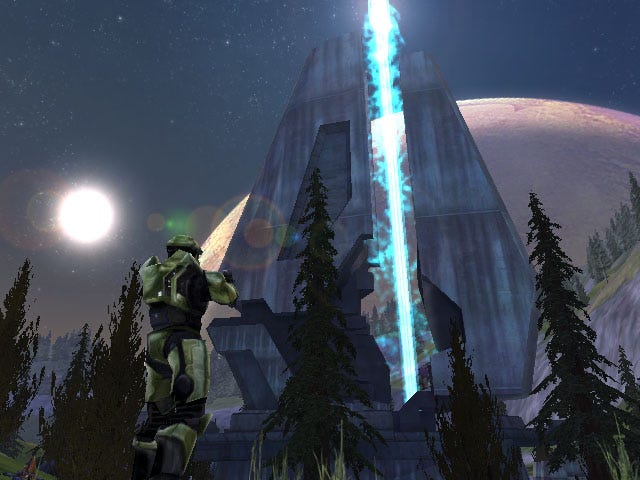

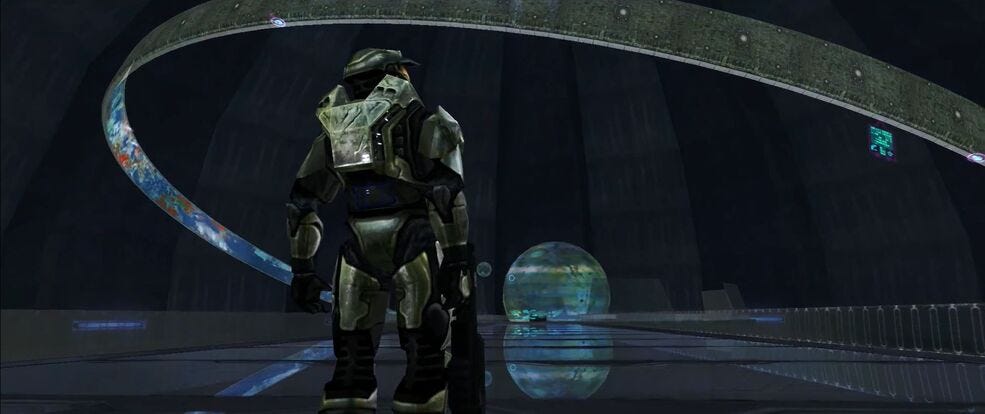
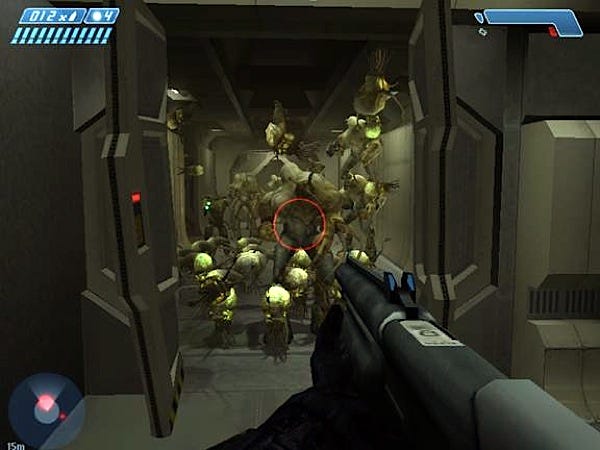
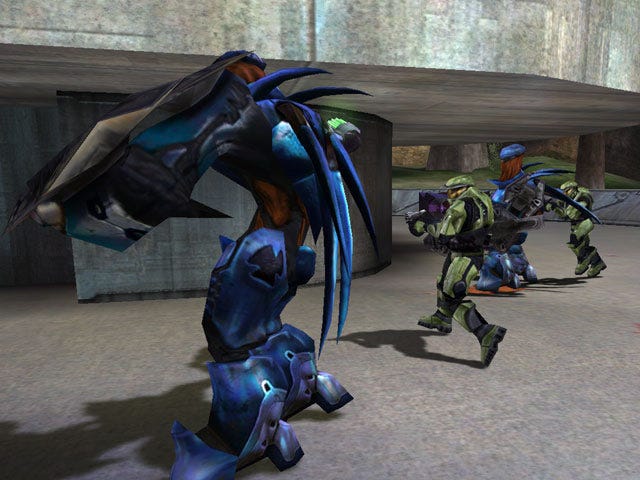
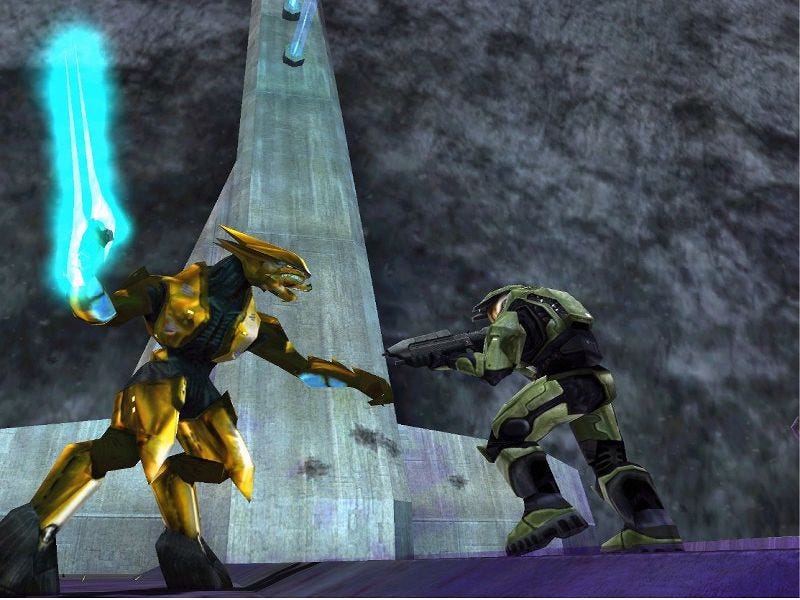
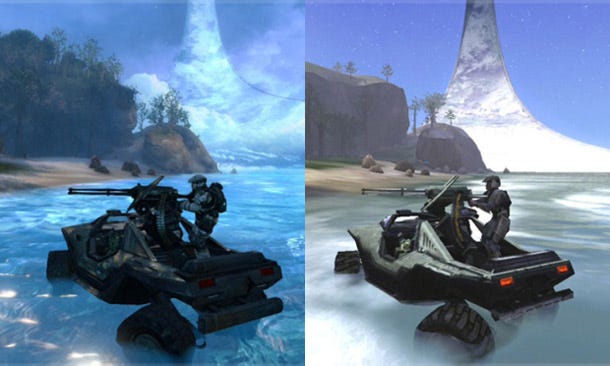

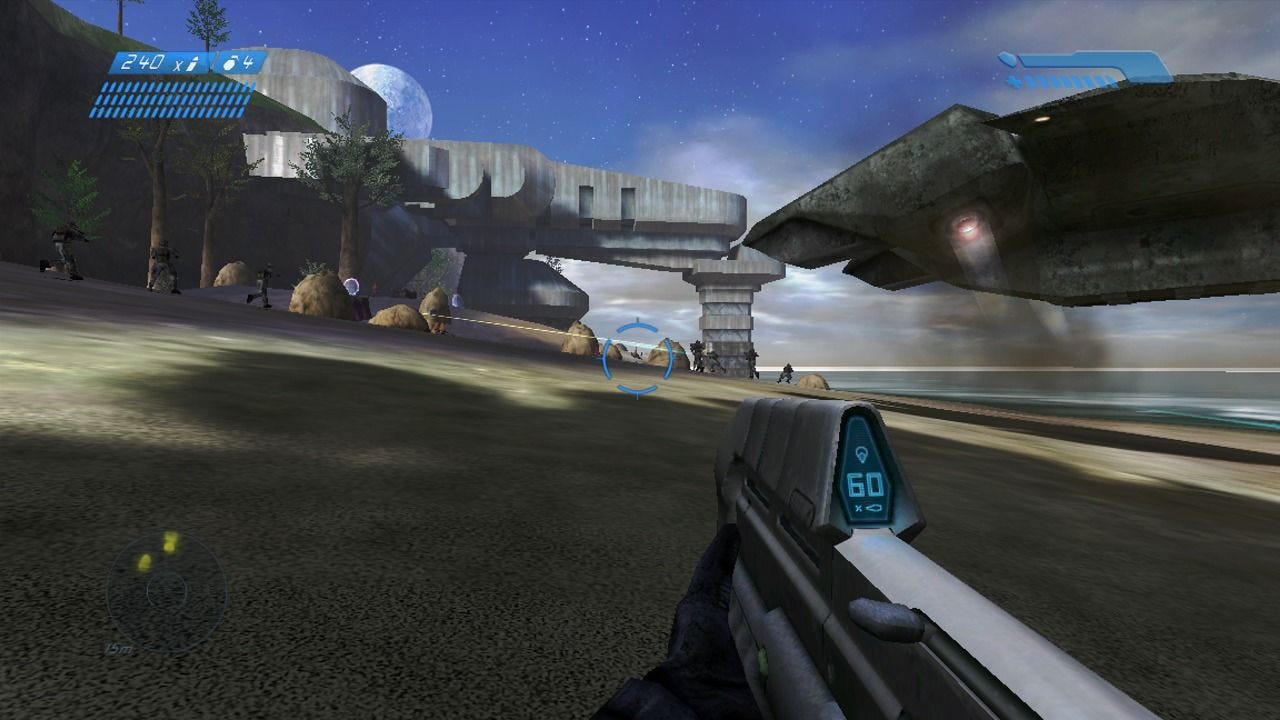
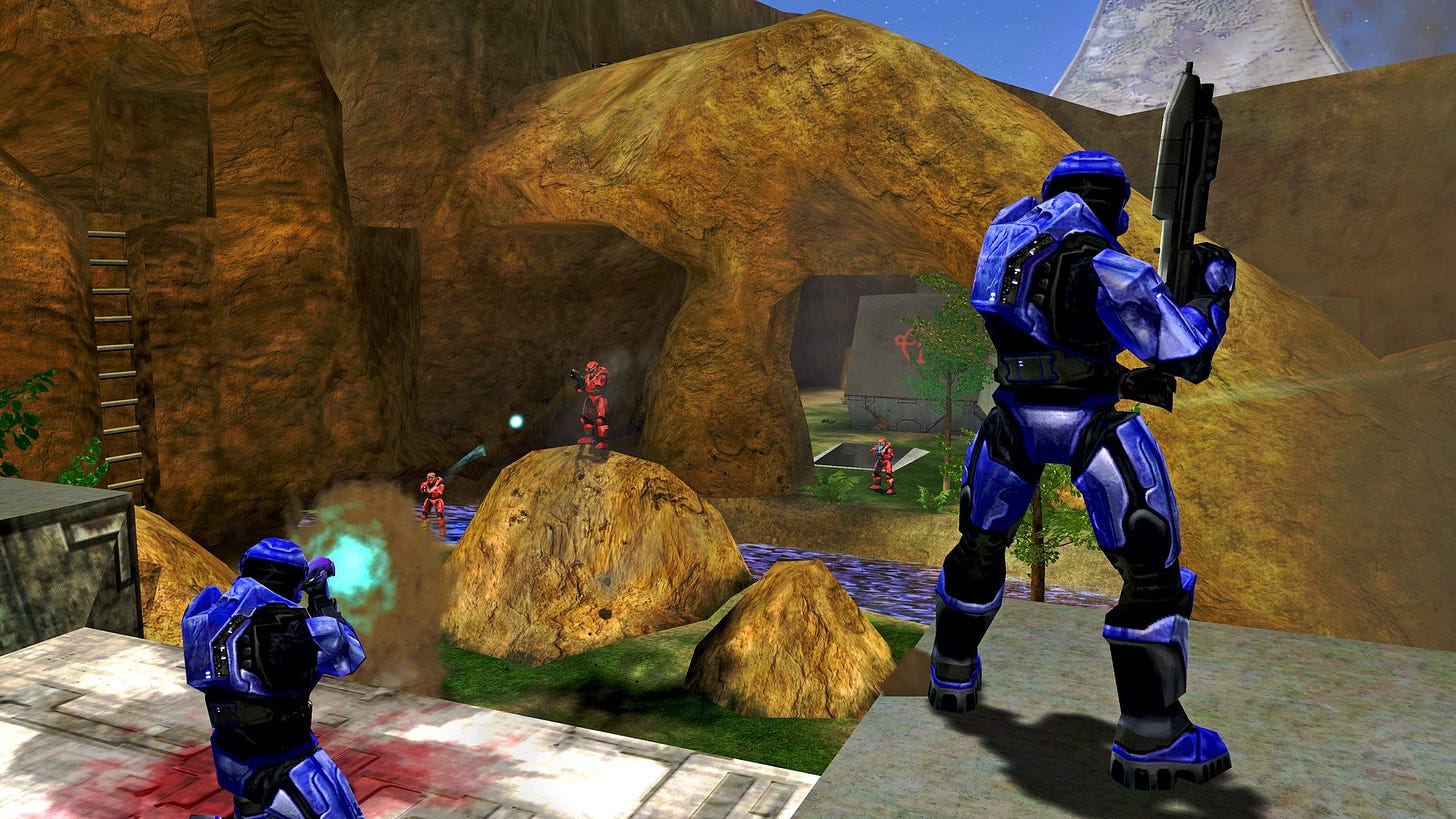
Enjoyed the review. This is helpful for me to try to get some insight into its appeal, because Halo is one of those games I just don't get. I didn't get it at the time, and I don't get it now: not too long ago I tried playing the Master Chief version couch co-op with a friend from out of town who was a big Halo fan growing up, but I still couldn't get into it at all, we dropped it at level 2. Ended up having a lot more fun playing some other couch co-op games with him.
I'll admit that I've never played Halo 2. I played Halo 3 some with friends when it was new, but also didn't get the appeal.
My friend did mention the existence of Halo LAN parties in high school, which you also mention, and I can get how that would be a formative experience for someone who grew up with it. We had PC LAN parties when I was in high school; in terms of FPSes we mainly played TFC and Counterstrike but occasionally some other less memorable stuff, and I suppose to me Halo would have fallen into the bucket of "other less memorable stuff."
The Flood, Trigens in Far Cry, the aliens in Crysis - is there a rule that every ground-breaking FPS has to have a miserable second half where most of the good ideas are thrown out entirely?